Power Conversion Techniques Using Multi-Phase Transformer: Configurations, Applications, Issues and Recommendations
Abstract
:1. Introduction
- (a)
- Complex design procedures.Multi-phase transformer design is not as straightforward as single-phase and three-phase transformer design due to multiple windings in each phase. Appropriate turn ratios and proper connection of multiple windings are vital in the creation of phasors of the multi-phase. Therefore, human expertise and knowledge are essential for designing multi-phase transformers.
- (b)
- Unequal series parameters.It is worth mentioning that the secondary of a multi-phase transformer is made from multiple windings with an unequal number of turns. This creates unequal series impedance of the secondary side which, in turn, creates unbalances in the output voltages. Hence, appropriate phase balancing is required to study the per phase equivalent circuit to achieve accurate outcomes.
- (c)
- Lack of fault and unbalancing studies.To find the sequence components of an unbalanced multi-phase voltage or current, the Fortescue theorem is necessary to investigate faults and any unbalancing of a multi-phase system. Unfortunately, these kinds of studies are very limited in the literature. Therefore, further studies are needed on fault and unbalancing studies.
- (d)
- Higher cost.The cost of a multi-phase transformer is higher due to larger copper requirements and design complexity. Thus, further exploration is necessary to reduce its price.
- A simplified and standard procedure to calculate the number of turns of primary and secondary windings of the multi-phase transformer is discussed.
- A three-phase to five-, seven-, eleven-, thirteen-phase transformer is discussed.
- Key issues and challenges of multi-phase power generated by three-phase to the multi-phase transformer are highlighted, discussed and accordingly, a few effective solutions are proposed.
- Some constructive recommendations are given at the end that open new research directions in the field of the multi-phase transformer.
2. Configuration of Phase Transformation Techniques
2.1. m-Phase to n-Phase Transformation
2.1.1. Two-Phase to n-Phase Transformation
2.1.2. Three-Phase to n-Phase Transformation Utilizing Optimization Methods
2.1.3. Three-Phase to n-Phase Transformation Using Phasor Algebra
2.2. Three-Phase to Five-Phase Transformation Configurations
2.2.1. Configuration 1
2.2.2. Configuration 2
2.2.3. Configuration 3
2.2.4. Comparison of Design Parameters
2.3. Three-Phase to Seven-Phase Transformation
2.3.1. Configuration 1
2.3.2. Configuration 2
- (a)
- Phase Voltage: Phase voltage with regards to neutral or star point O (e.g., Va, Vb, Vc, Vd, Ve, Vf, and Vg);
- (b)
- Adjacent Line Voltage: The voltage difference of two phases having a phase difference of 51.42° (e.g., Vab1, Vb1c, Vcd, Vde, Vef, Vfg, and Vga);
- (c)
- Nonadjacent1 Line Voltage: The voltage difference of two phases having a phase difference of 2 × 51.42° (e.g., Vac, Vb1d, Vce, Vdf, Veg, Vfa, and Vgb);
- (d)
- Nonadjacent2 Line Voltage: The voltage difference of two phases having a phase difference of 3 × 51.42° (e.g., Vad, Vb1e, Vcf, Vdg, Vea, Vfb1, and Vgc).
2.4. Other High Phase Order Systems
2.4.1. Three-Phase to Eleven-Phase System
2.4.2. Three-Phase to Thirteen-Phase Transformer
- A star-connected input and star-connected output;
- A star-connected input and tridecagon-connected output;
- A delta-connected input and star-connected output;
- A delta-connected input and tridecagon-connected output.
3. Applications of a Multi-Phase Transformer
3.1. Electric Drives
3.2. Transmission of Bulk Power
3.3. Wind Energy Conversion System
3.4. HVDC Transmission System
4. Issues and Challenges of Multi-Phase Transformer
4.1. Impedance Mismatching
4.2. Voltage Unbalance
4.3. Per-Phase Equivalent Circuit Modeling
4.3.1. Formulation of Objective Function and Analytical Modeling
4.3.2. Simulation Results
4.4. Fault Analysis of a Multi-Phase Transformer
- Fault Analysis of Multi-phase System: The fault analysis is an essential tool for evaluating various faults occurring in a specified electrical system. The appropriate information and data are needed to choose various equipment of specified ratings. The existing research works on fault analysis for a three-phase system is mature and abundant in literature but Fault analysis for a multi-phase system is absent. Therefore, an in-depth investigation is needed to develop a fault analysis mechanism of a multi-phase system.
- Per-phase equivalent circuit: An important design consideration to analyze various multi-phase transformation techniques is implementing the per-phase equivalent technique. A per-phase equivalent circuit is an Unequal number of turns in each winding of a multi-phase transformer that leads to unequal series impedance. Therefore, developing a per-phase equivalent circuit for a multi-phase transformer is a challenging task and maybe future research direction.
- Fixed Frequency operation: Usually, the converter circuits operate at a fixed frequency; nonetheless, the phase displacement controls the output voltage at the latter conversion stages. In the case of a transformer, the operation is conducted at a fixed frequency; nonetheless, it is not suitable for a variable frequency drive. In association with this multi-phase VSI has superiority over multi-phase transformer.
- Lack of multi-phase Circuit breaker and Relays: The circuit breaker and relays are considered important equipment for control and protection in electrical power systems. However, the application of multi-phase circuit breakers and relay has not been explored significantly. Therefore, the development of circuit breakers and relays operating at multi-phase power might be breakthrough research.
5. Validation and Experimental Results
5.1. Experiment 1
5.2. Experiment 2
6. Conclusions and Recommendations
- An in-depth comparative analysis of efficiencies between three-phase and multi-phase transformers is essential to be performed.
- Thermal modeling of a transformer is performed to accurately predict winding and the component temperature rises above ambient temperature. Each phase of a multi-phase transformer winding comprises two or more windings. Connecting windings together may cause a local hotspot if not appropriately addressed. Therefore, advanced thermal modeling of a multi-phase transformer is necessary to examine the winding temperature, oil temperature, and local hotspot at the winding junction point.
- The finite element method (FEM) is used to simulate the core losses of a transformer and investigate the flux density behavior in the transformer’s core. Hence, it is vital in the design process of a transformer, especially a multi-phase transformer. Substantial literature can be found for finite element analysis of a three-phase transformer. Different numbers of turns for each phase in a multi-phase transformer may create a spark at the junction or joint, leading to localized hotspots or discharge. A finite element analysis-based five-phase transformer design is presented in the literature but the study is limited to magnetics only. The same can be extended to all multi-phase transformers.
- Further exploration related to the fault tolerance ability of the multi-phase conversion system can be carried out, which could lead to an increase in robustness and efficiency.
- The multi-phase circuit breaker and electrical relay are significant in future research activities. Therefore, the execution of multi-phase circuit breakers and relay circuits in a multi-phase system needs to be further investigated.
Author Contributions
Funding
Institutional Review Board Statement
Informed Consent Statement
Data Availability Statement
Conflicts of Interest
References
- Parton, J.E. A general theory of phase transformation. Proc. IEEE Part. IV Inst. Monogr. 1952, 99, 12–23. [Google Scholar] [CrossRef]
- Levi, E. Multiphase electric machines for variable-speed applications. IEEE Trans. Ind. Electron. 2008, 55, 1893–1909. [Google Scholar] [CrossRef]
- Bruyère, A.; Semail, E.; Bouscayrol, A.; Locment, F.; Dubus, J.-M.; Mipo, J.-C. Modeling and control of a seven-phase claw-pole integrated starter alternator for micro-hybrid automotive applications. In Proceedings of the 2008 IEEE Vehicle Power and Propulsion Conference, Harbin, China, 3–5 September 2008; pp. 1–6. [Google Scholar] [CrossRef] [Green Version]
- Iqbal, A.; Ahmed, S.M.; Abu-Rub, H. Space vector PWM technique for a three-to-five-phase matrix converter. IEEE Trans. Ind. Appl. 2012, 48, 697–707. [Google Scholar] [CrossRef]
- Moinoddin, S.; Iqbal, A.; Abu-Rub, H.; Khan, M.R.; Ahmed, S.M. Three-phase to seven-phase power converting transformer. IEEE Trans. Energy Convers. 2012, 27, 757–766. [Google Scholar] [CrossRef]
- Iqbal, A.; Moinuddin, S.; Khan, M.R.; Ahmed, S.M.; Abu-Rub, H. A novel three-phase to five-phase transformation using a special transformer connection. IEEE Trans. Power Deliv. 2010, 25, 1637–1644. [Google Scholar] [CrossRef]
- Abdel-Khalik, A.; Shafik, Z.; Elserougi, A.; Ahmed, S.; Massoud, A. A static three-phase to five-phase transformer based on Scott connection. Electr. Power Syst. Res. 2014, 110, 84–93. [Google Scholar] [CrossRef]
- Tiwari, S.; Singh, G.; Bin Saroor, A. Multiphase power transmission research—A survey. Electr. Power Syst. Res. 1992, 24, 207–215. [Google Scholar] [CrossRef]
- Saleh, M.; Iqbal, A.; Kalam, A.; Abu-Rub, H. Carrier-based pulse width modulation technique for a three-to-five phase matrix converter for supplying five-phase two-motor drives. Int. J. Eng. Sci. Technol. 2010, 2, 67–78. [Google Scholar] [CrossRef] [Green Version]
- Chen, X. A three-phase multi-legged transformer model in ATP using the directly-formed inverse inductance matrix. IEEE Trans. Power Deliv. 1996, 11, 1554–1562. [Google Scholar] [CrossRef]
- Itoh, J.; Chiang, G.T.; Member, S.; Maki, K. Beatless synchronous PWM control for in a matrix converter. IEEE Trans. Power Electron. 2013, 28, 1338–1347. [Google Scholar] [CrossRef]
- Ahmed, S.M.; Abu-Rub, H.; Salam, Z.; Kouzou, A.; Ahmed, S.M.; Abdellah, K. Space vector PWM technique for a novel three-to-seven phase matrix converter. In Proceedings of the 39th Annual Conference of the IEEE Industrial Electronics Society (IECON 2013), Vienna, Austria, 10–13 November 2013; pp. 4949–4954. [Google Scholar] [CrossRef]
- Brandwajn, V.; Dommel, H.W.; Dommel, I.I. Matrix representation of three-phase N-winding transformers for steady-state and transient studies. IEEE Trans. Power Appar. Syst. 1982, 101, 1369–1378. [Google Scholar] [CrossRef]
- Khelafi, A.; Djebli, A.; Ouadah, M.; Touhami, O.; Ibtiouen, R. Control of five-phase induction machine with three-phase inverter via three-to-five phase transformer. In Proceedings of the 2020 International Conference on Electrical Machines (ICEM), Gothenburg, Sweden, 23–26 August 2020; pp. 2083–2089. [Google Scholar]
- Kim, D.; Ma, J.; Kim, J. Phase to phase interleaved method to reduce the common mode voltage for seven phase BLDCM drive. In Proceedings of the 2019 10th International Conference on Power Electronics and ECCE Asia (ICPE 2019—ECCE Asia), Busan, Korea, 27–30 May 2019; pp. 1–7. [Google Scholar]
- Reddy, B.P.; Meraj, M.; Iqbal, A.; Keerthipati, S.; Al-Hitmi, M. A single DC source-based three-level inverter topology for a four-pole open-end winding nine-phase PPMIM drives. IEEE Trans. Ind. Electron. 2021, 68, 2750–2759. [Google Scholar] [CrossRef]
- Reddy, B.P.; Meraj, M.; Iqbal, A.; Keerthipati, S.; Bhaskar, M.S. A hybrid multilevel inverter scheme for nine-phase PPMIM drive by using three-phase five-leg inverters. IEEE Trans. Ind. Electron. 2021, 68, 1895–1904. [Google Scholar] [CrossRef]
- Abdel-Khalik, A.S.; Massoud, A.; Ahmed, S. Standard three-phase stator frames for multiphase machines of prime-phase order: Optimal selection of slot/pole combination. IEEE Access 2019, 7, 78239–78259. [Google Scholar] [CrossRef]
- Khan, M.R.; Iqbal, A.; Ahmed, S.M.; Moinuddin, S.; Payami, S. Multi-phase alternative current machine winding design. Int. J. Eng. Sci. Technol. 2010, 2, 79–86. [Google Scholar] [CrossRef] [Green Version]
- Tabrez, M.; Sadhu, P.K.; Iqbal, A. A novel three-phase to seven-phase conversion technique using transformer winding con-nections. Eng. Technol. Appl. Sci. Res. 2017, 7, 1953–1961. [Google Scholar] [CrossRef]
- Djebli, A.; Touhami, O.; Ibtiouen, R. Configuration of three-phase to eleven-phase power transformer. In Proceedings of the 2018 International Conference on Electrical Sciences and Technologies in Maghreb (CISTEM), Algiers, Algeria, 28–31 October 2018; pp. 1–6. [Google Scholar]
- Mohammad, E.; Khan, F.; Bassel, H.; Iqbal, A.; Riyaz, A. Comparative analysis of three-phase to five-phase transformer connections. Aust. J. Electr. Electron. Eng. 2017, 14, 20–29. [Google Scholar] [CrossRef]
- Siafullah, P.; Iqbal, A.; Abu-Rub, H. Analytical and Graphical tool to analyse unbalanced five-phase system. Int. J. Recent Trends Eng. 2010, 3, 146–150. [Google Scholar]
- Tabrez, M.; Sadhu, P.K.; Iqbal, A.; Bakhsh, F.I. Analysis of a three-phase to seven-phase transformer under unbalanced input. Microsyst. Technol. 2020, 26, 2507–2516. [Google Scholar] [CrossRef]
- Karekar, S. A novel scheme of three to eleven phases transformer connection by using MATLAB software. J. Mater. Sci. 2018, 4, 555627. [Google Scholar] [CrossRef]
- Somashekar, B. A novel theory of three phases to eleven phases. Int. J. Recent Innov. Trends Comput. Commun. 2014, 2, 3828–3834. [Google Scholar]
- Razali, N.M.; Geraghty, J. Genetic algorithm performance with different selection strategies in solving TSP. In Proceedings of the World Congress on Engineering, London, UK, 6–8 July 2011; Volume II. [Google Scholar]
- Deepika, J.; Sujatha, B.C.; Singh, S.P. A novel design of three phase to thirteen phase power converting transformer. In Proceedings of the 2019 4th International Conference on Electrical, Electronics, Communication, Computer Technologies and Optimization Techniques (ICEECCOT), Mysuru, India, 13–14 December 2019; pp. 44–48. [Google Scholar]
- Dujic, D.; Levi, E.; Jones, M.; Grandi, G.; Serra, G.; Tani, A. Continuous PWM techniques for sinusoidal voltage generation with seven-phase voltage source inverters. In Proceedings of the IEEE Annual Power Electronics Specialists Conference, Puerto Varas, Chile, 4–7 December 2017; pp. 47–52. [Google Scholar]
- Ward, E.; Harer, H. Preliminary investigation of an inverter-fed 5-phase induction motor. IEEE Proc. 1969, 116, 980–984. [Google Scholar]
- El-Kahel, M.; Olivier, G.; Guimaraes, C.; April, G.E. Five and seven-phase converter transformers. In Proceedings of the Canadian Conference on Electrical and Computer Engineering (CCECE), Montreal, QC, Canada, 5–8 September 1995; pp. 708–711. [Google Scholar]
- El-Kahel, M.; Olivier, G.; Ba, A.O. Five and seven-phases converters: A feasibility study. In Proceedings of the Canadian Conference on Electrical and Computer Engineering (CCECE), Calgary, QC, Canada, 26–28 May 1996; pp. 1000–1003. [Google Scholar]
- Yan, X.Q.; Xu, Z.Y.; Wen, A.; Yang, Q.X. Fault analysis principle for twelve-phase transmission system. In Proceedings of the 2012 IEEE Power and Energy Society General Meeting, San Diego, CA, USA, 22–26 July 2012; pp. 1–6. [Google Scholar]
- Dorazio, T. High phase order transmission. In Proceedings of the 1990 IEEE Southern Tier Technical Conference on Southern Tier, Binghamton, NY, USA, 25 April 1990; pp. 31–36. [Google Scholar]
- Xu, P.; Wang, G.; Li, H.; Liang, Y.; Zhang, P. A new method for open conductors fault calculation of four-parallel transmission lines. In Proceedings of the 2010 Asia-Pacific Power and Energy Engineering Conference, Chengdu, China, 28–31 March 2010; pp. 1–4. [Google Scholar]
- Stewartand, J.R.; Wilson, D.D. High phase order transmission—A feasibility analysis—Part-I: Steady state considerations. IEEE Trans. Power A Syst. 1978, 97, 2300–2307. [Google Scholar] [CrossRef]
- Koley, E.; Jain, A.; Thoke, A.S.; Jain, A.; Ghosh, S. Detection and classification of faults on six phase transmission line using ANN. In Proceedings of the 2011 2nd International Conference on Computer and Communication Technology (ICCCT-2011), Allahabad, India, 15–17 September 2011; Volumes 15–17, pp. 100–103. [Google Scholar]
- Kant, P.; Singh, B. A new three-phase to five-phase transformer with power quality improvement in hybrid-multilevel inverter based VCIMD. IEEE Trans. Power Deliv. 2020, 35, 871–880. [Google Scholar] [CrossRef]
- Chandramohan, K.; Padmanaban, S.; Kalyanasundaram, R.; Bhaskar, M.S.; Mihet-Popa, L. Grid synchronization of a seven-phase wind electric generator using d-q PLL. Energies 2017, 10, 926. [Google Scholar] [CrossRef] [Green Version]
- Al-Ammari, R.; Iqbal, A.; Khandakar, A.; Rahman, S.; Padmanaban, S. Systematic implementation of multi-phase power supply (three to six) conversion system. Electronics 2019, 8, 109. [Google Scholar] [CrossRef] [Green Version]
- Riad, N.; Anis, W.; ElKassas, A.; Hassan, A. Three-phase multilevel inverter using selective harmonic elimination with marine predator algorithm. Electronics 2021, 10, 374. [Google Scholar] [CrossRef]
- Kesbia, N.; Schanen, J.-L.; Alawieh, H.; Garbuio, L.; Avenas, Y. Design by optimization of multiphase inverter for electric vehicle drive. In Proceedings of the 2020 22nd European Conference on Power Electronics and Applications (EPE’20 ECCE Europe), Lyon, France, 7–11 September 2010; IEEE: Piscataway, NJ, USA, 2020; pp. 1–8. [Google Scholar]
- Booin, M.B.; Cheraghi, M. THD minimization in a five-phase five-level vsi using a novel SVPWM technique. In Proceedings of the 2019 10th International Power Electronics, Drive Systems and Technologies Conference (PEDSTC), Shiraz, Iran, 12–14 February 2019; IEEE: Piscataway, NJ, USA, 2019; pp. 285–290. [Google Scholar]
- Razali, Noraini Mohd. "An efficient genetic algorithm for large scale vehicle routing problem subject to precedence constraints. Proc. Soc. Behav. Sci. 2015, 195, 1922–1931. [CrossRef] [Green Version]
- Warathe, S.; Patel, R.N. Six-phase transmission line over current protection by numerical relay. In Proceedings of the 2015 International Conference on Advanced Computing and Communication Systems, Coimbatore, India, 5–7 January 2015; pp. 1–5. [Google Scholar]
- Khan, M.R.; Alammari, R.; Moinoddin, S.; Iqbal, A. Modelling and analysis of a three-phase to five-phase transformer. Int. J. Emerg. Electr. Power Syst. 2014, 15, 401–410. [Google Scholar] [CrossRef]
- Yusoff, N.A.M.; Karim, K.A.; Ab Ghani, S.; Sutikno, T.; Jidin, A. Multiphase transformer modelling using finite element method. Int. J. Power Electron. Drive Syst. IJPEDS 2015, 6, 56. [Google Scholar] [CrossRef] [Green Version]
- Huang, J. Transformer and Method of Generating Multiple Multiphase Output Signals. USA Patent Application 16/417,204, 26 November 2020. [Google Scholar]
- Gao, Z.; Liu, X. An overview on fault diagnosis, prognosis and resilient control for wind turbine systems. Processes 2021, 9, 300. [Google Scholar] [CrossRef]
- Pillay, P.; Manyage, M. Definitions of voltage unbalance. IEEE Power Eng. Rev. 2001, 21, 49–51. [Google Scholar] [CrossRef]
- Tabrez, M.; Bakhsh, F.I.; Hassan, M.; Shamganth, K.; Al-Ghnimi, S. A comparative simulation study of different sensorless permanent magnet synchronous motor drives using neural network and fuzzy logic. J. Intell. Fuzzy Syst. 2018, 35, 5177–5184. [Google Scholar] [CrossRef]
- Tabrez, M.; Iqbal, A.; Sadhu, P.K.; Husain, M.A.; Bakhsh, F.I.; Singh, S.P. Equivalent circuit modelling of a three-phase to seven-phase transformer using PSO. J. Intell. Fuzzy Syst. 2021, in press. [Google Scholar] [CrossRef]
- Yang, Z.; Chen, Y. Interturn Short-Circuit Fault Detection of a Five-Phase Permanent Magnet Synchronous Motor. Energies 2021, 14, 434. [Google Scholar] [CrossRef]
- Toader, D.; Vintan, M.; Solea, C.; Vesa, D.; Greconici, M. Analysis of the Possibilities of Selective Detection of a Single Line-to-Ground Fault in a Medium Voltage Network with Isolated Neutral. Energies 2021, 14, 7019. [Google Scholar] [CrossRef]
- Wang, M.; Vandermaar, A.J.; Srivastava, K.D. Review of condition assessment of power transformers in service. IEEE Electr. Insul. Mag. 2002, 18, 12–25. [Google Scholar] [CrossRef]
- Alsuhaibani, S.; Khan, Y.; Beroual, A.; Malik, N.H. A review of frequency response analysis methods for power transformer diagnostics. Energies 2016, 9, 879. [Google Scholar] [CrossRef] [Green Version]
- Liang, X.; Liu, J.; Li, H.; Zhao, B.; Li, C.; Zuo, X. An Analytical Method for Pulse Transformer-Based Inductive Pulsed Power Supply Circuit. IEEE Trans. Appl. Supercond. 2021, 31, 1–4. [Google Scholar] [CrossRef]
- Duval, M. A review of faults detectable by gas-in-oil analysis in transformers. IEEE Electr. Insul. Mag. 2002, 18, 8–17. [Google Scholar] [CrossRef] [Green Version]
- Hannan, M.A.; Ker, P.J.; Lipu, M.S.H.; Choi, Z.H.; Rahman, M.S.A.; Muttaqi, K.M.; Blaabjerg, F. State of the Art of Solid-State Transformers: Advanced Topologies, Implementation Issues, Recent Progress and Improvements. IEEE Access 2020, 8, 19113–19132. [Google Scholar] [CrossRef]
- Almaguer, J.; Cárdenas, V.; Espinoza, J.; Aganza-Torres, A.; González, M. Performance and Control Strategy of Real-Time Simulation of a Three-Phase Solid-State Transformer. Appl. Sci. 2019, 9, 789. [Google Scholar] [CrossRef] [Green Version]

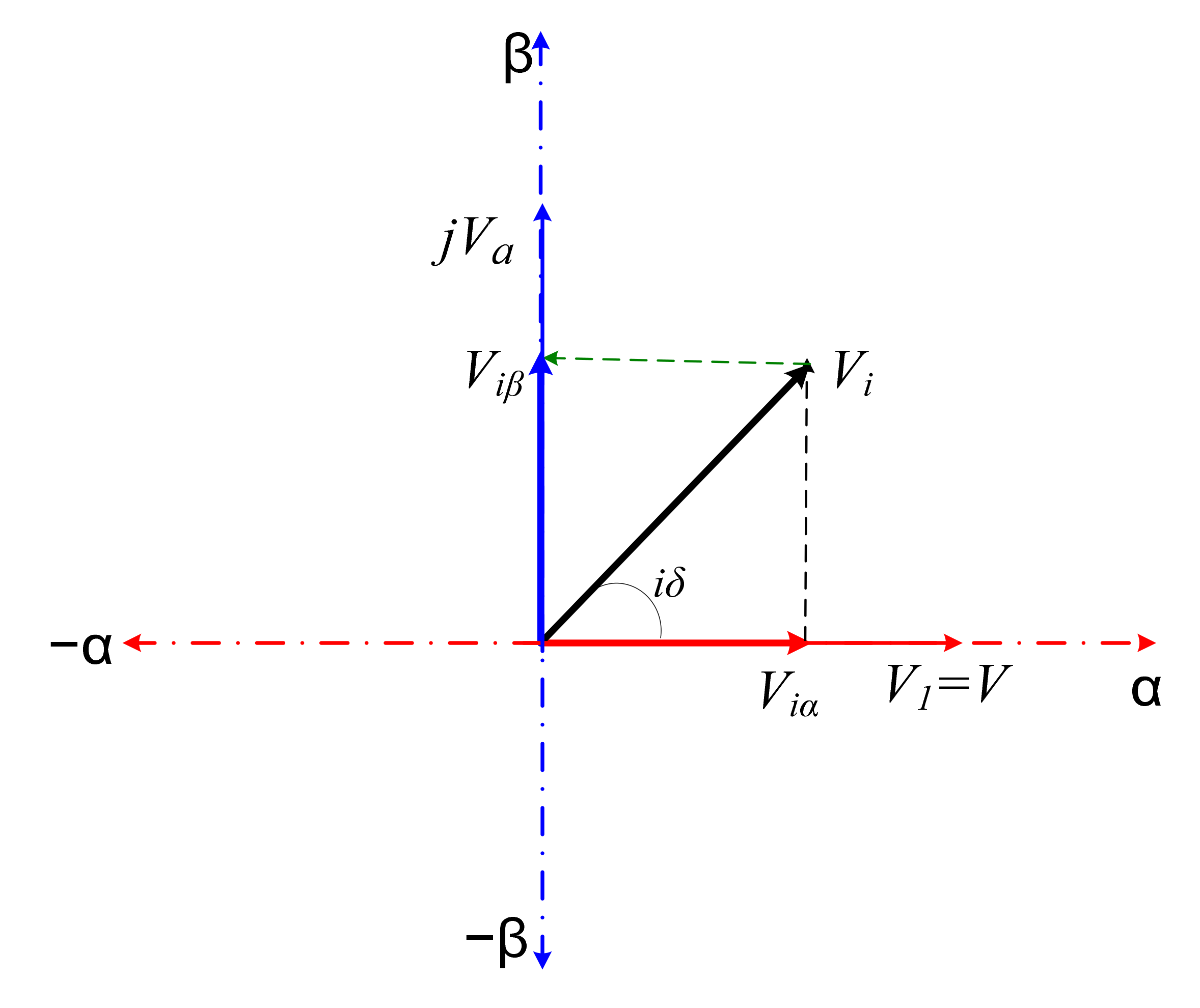


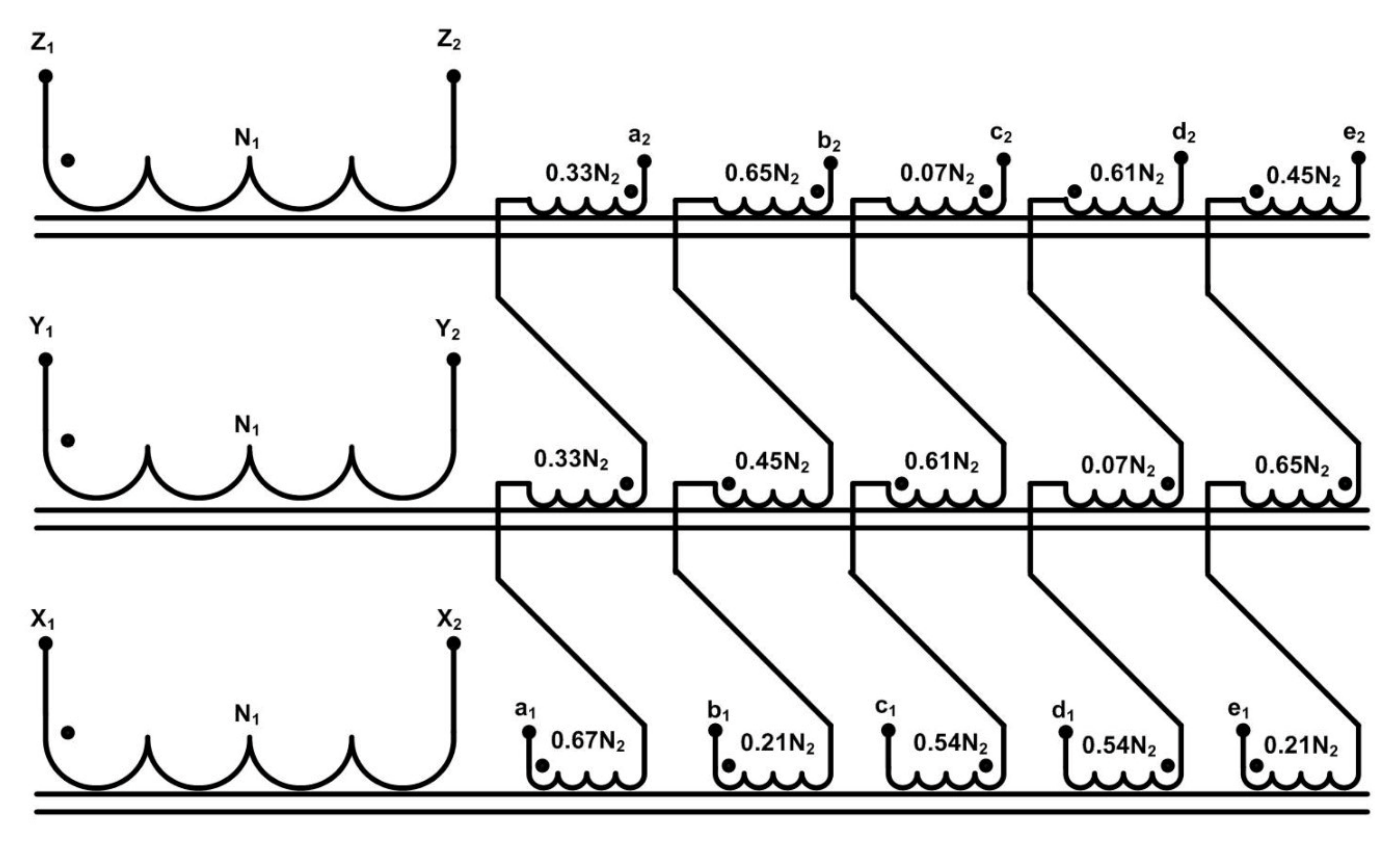
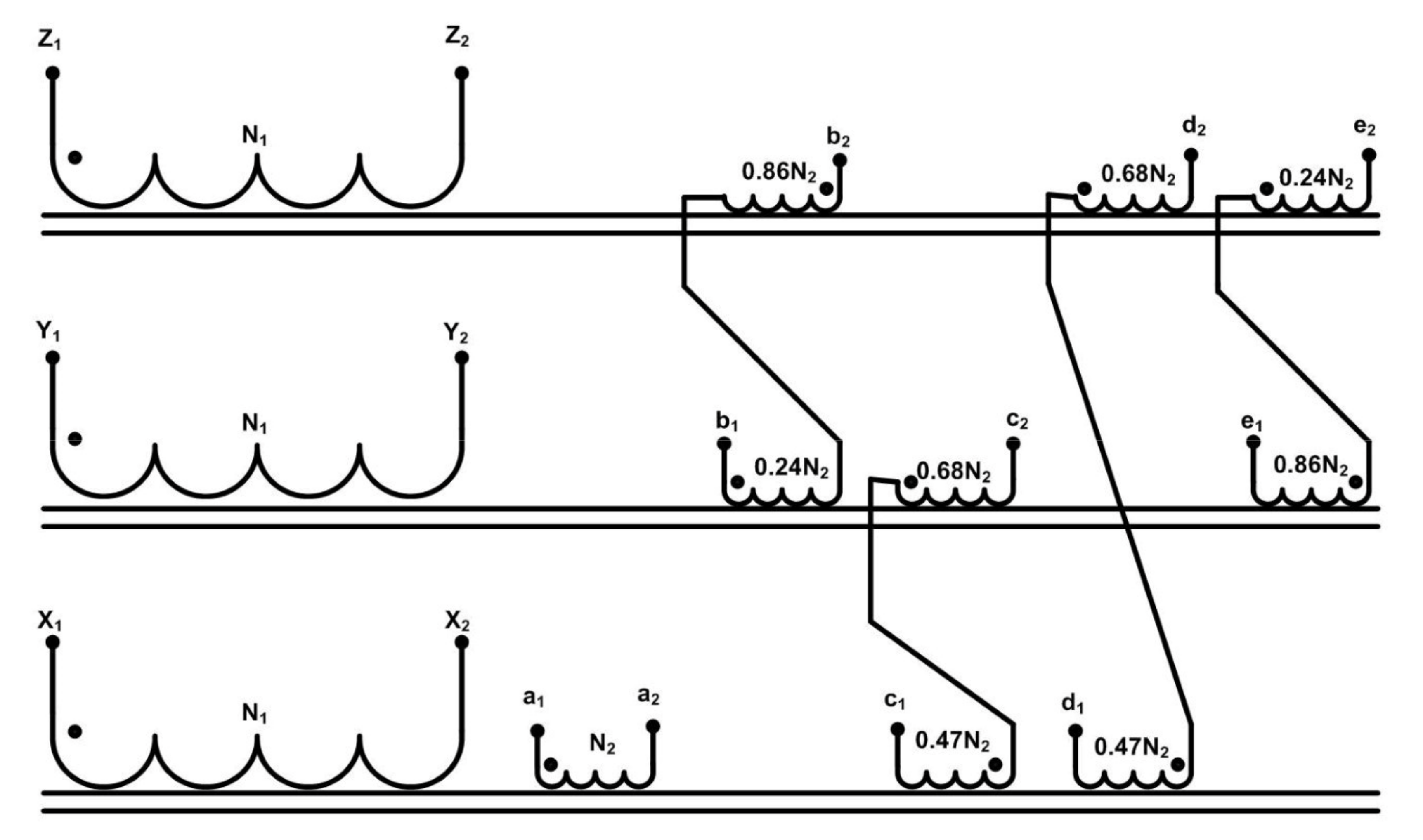
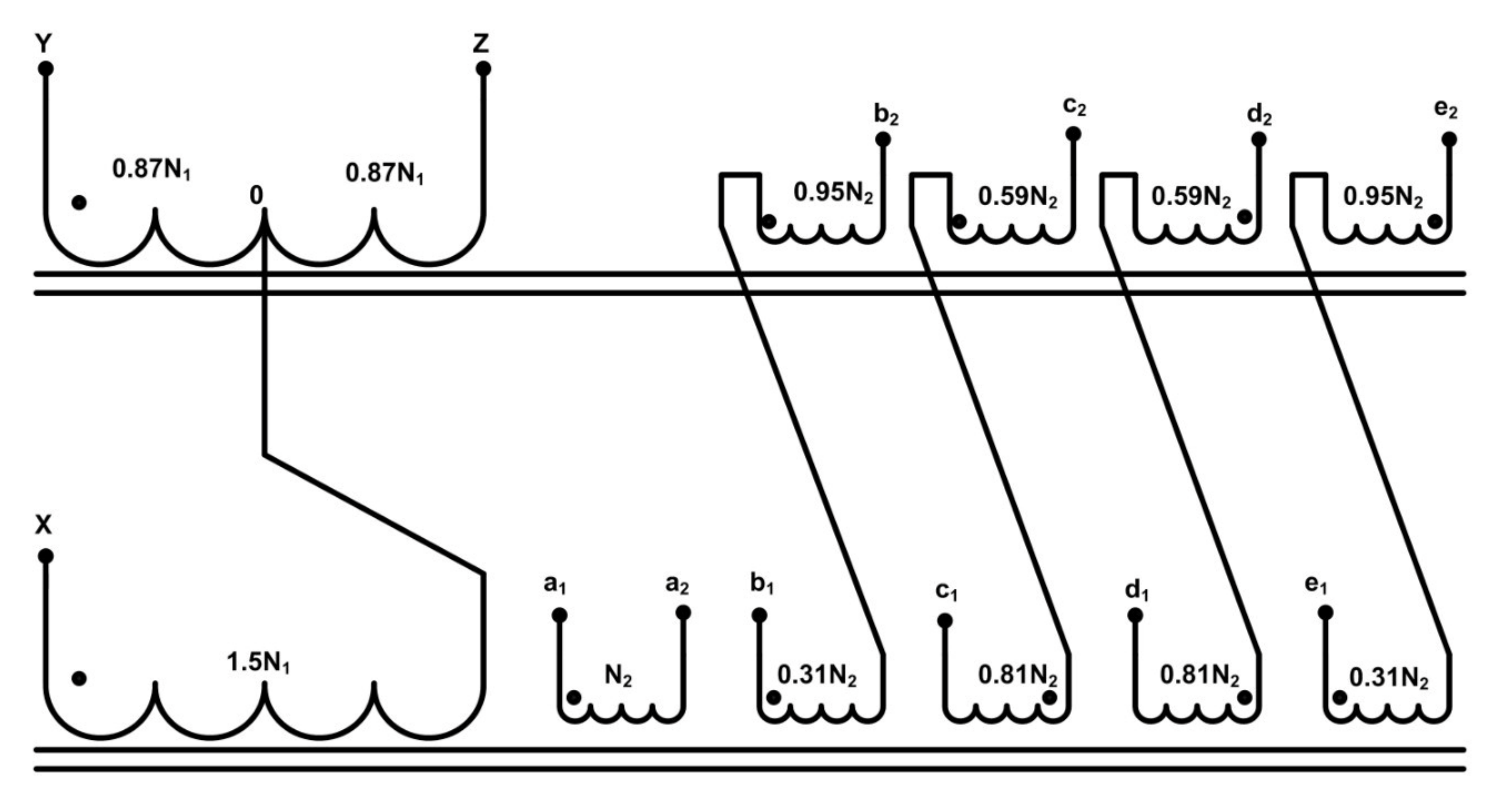
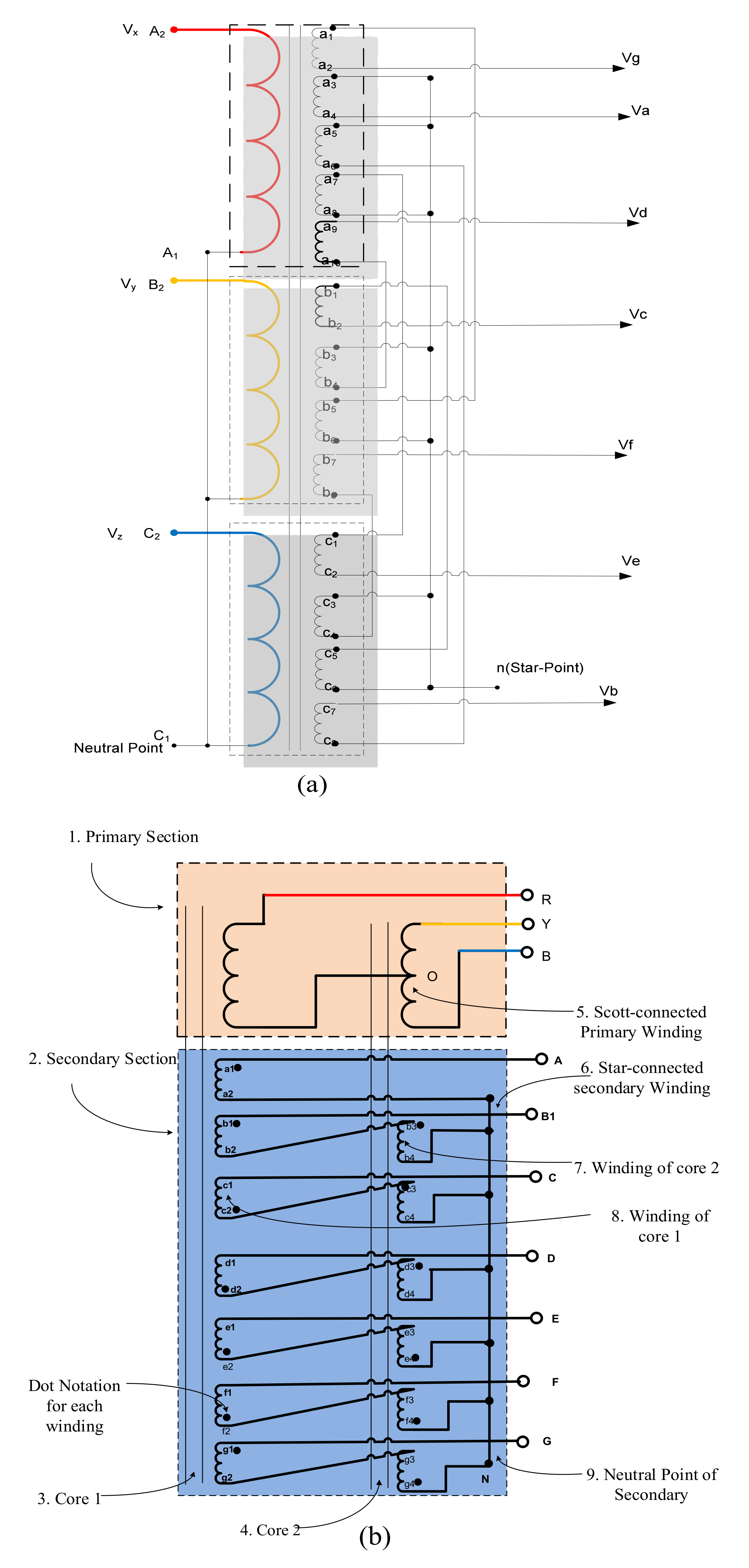

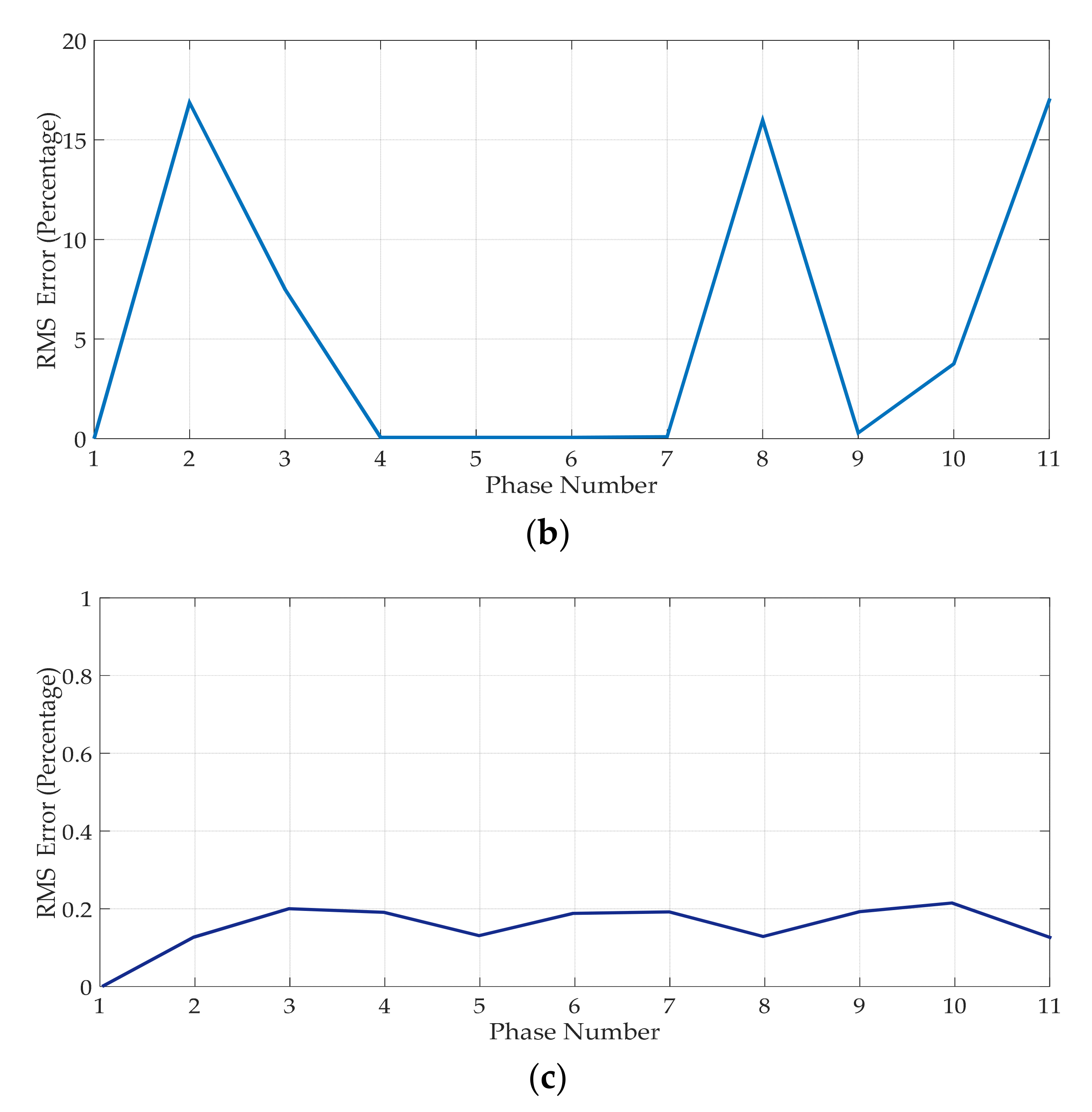
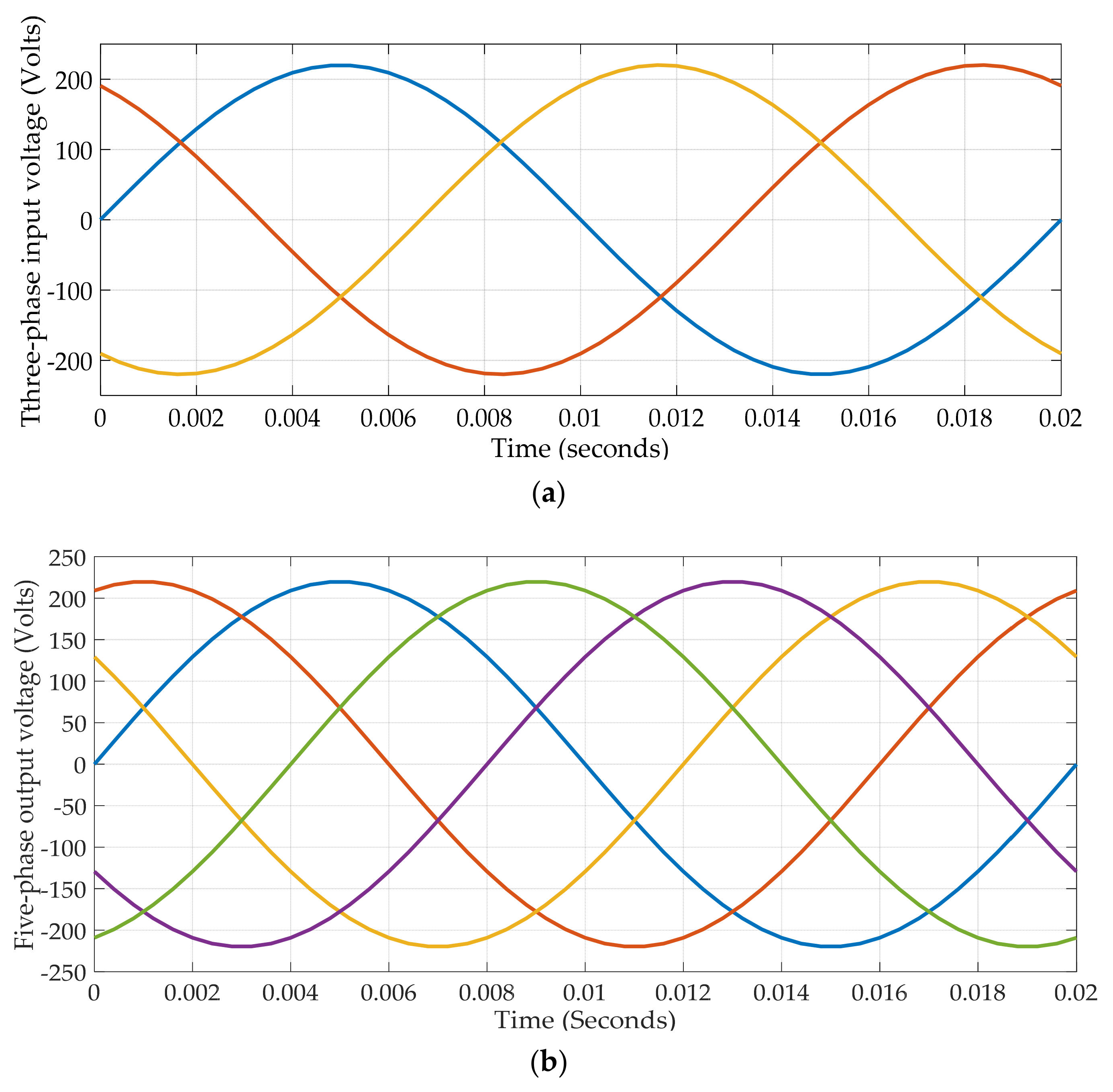





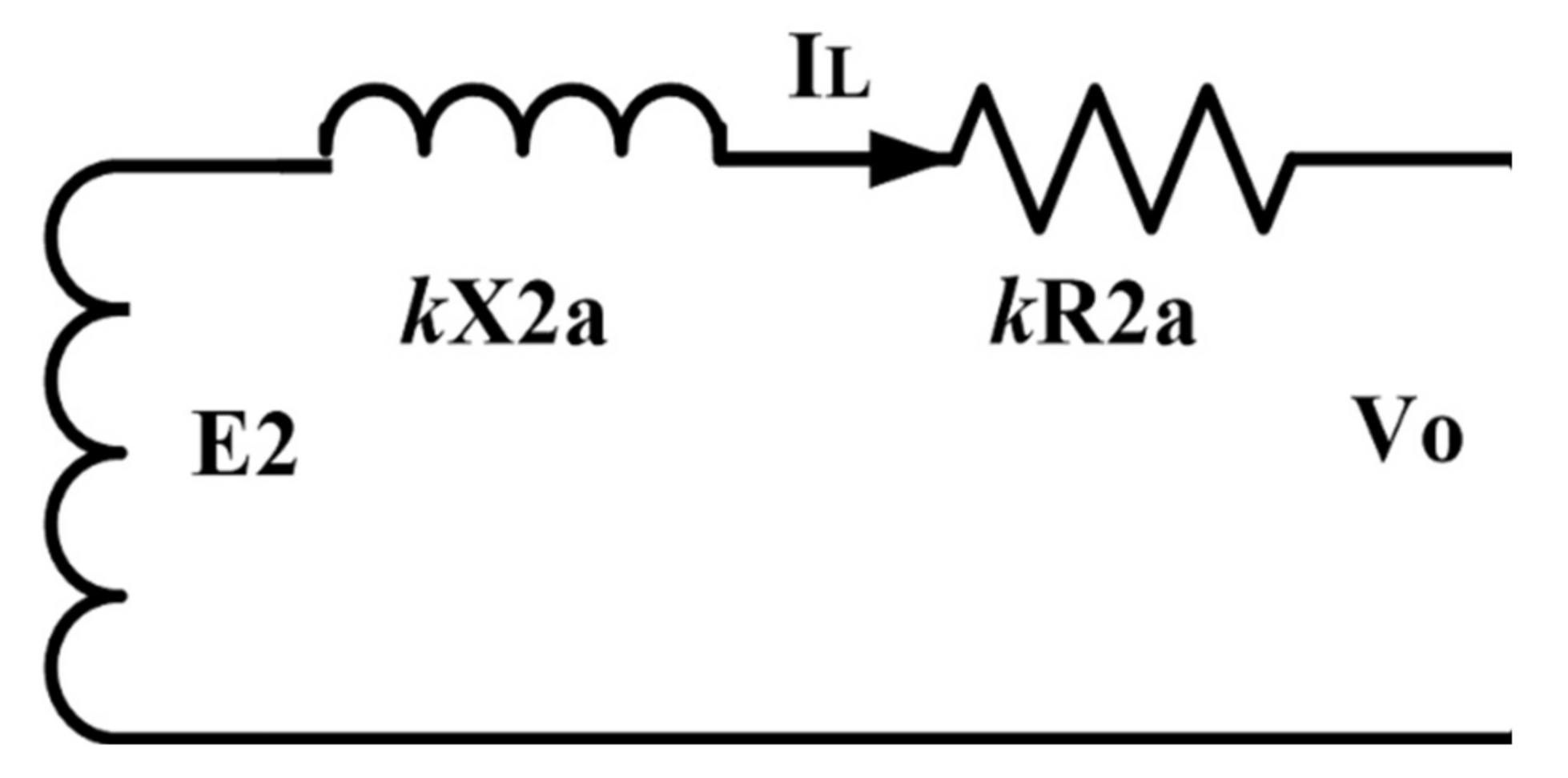

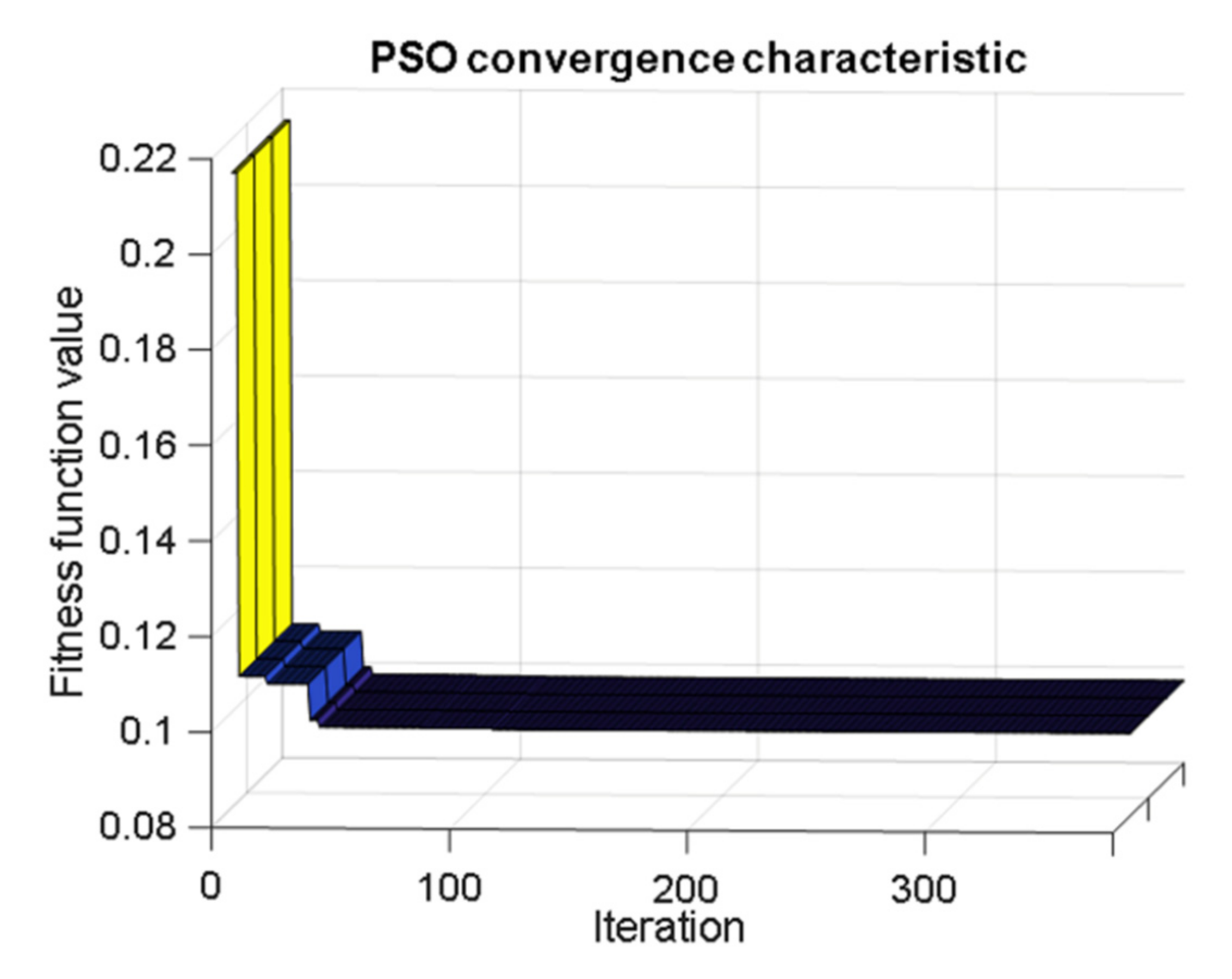
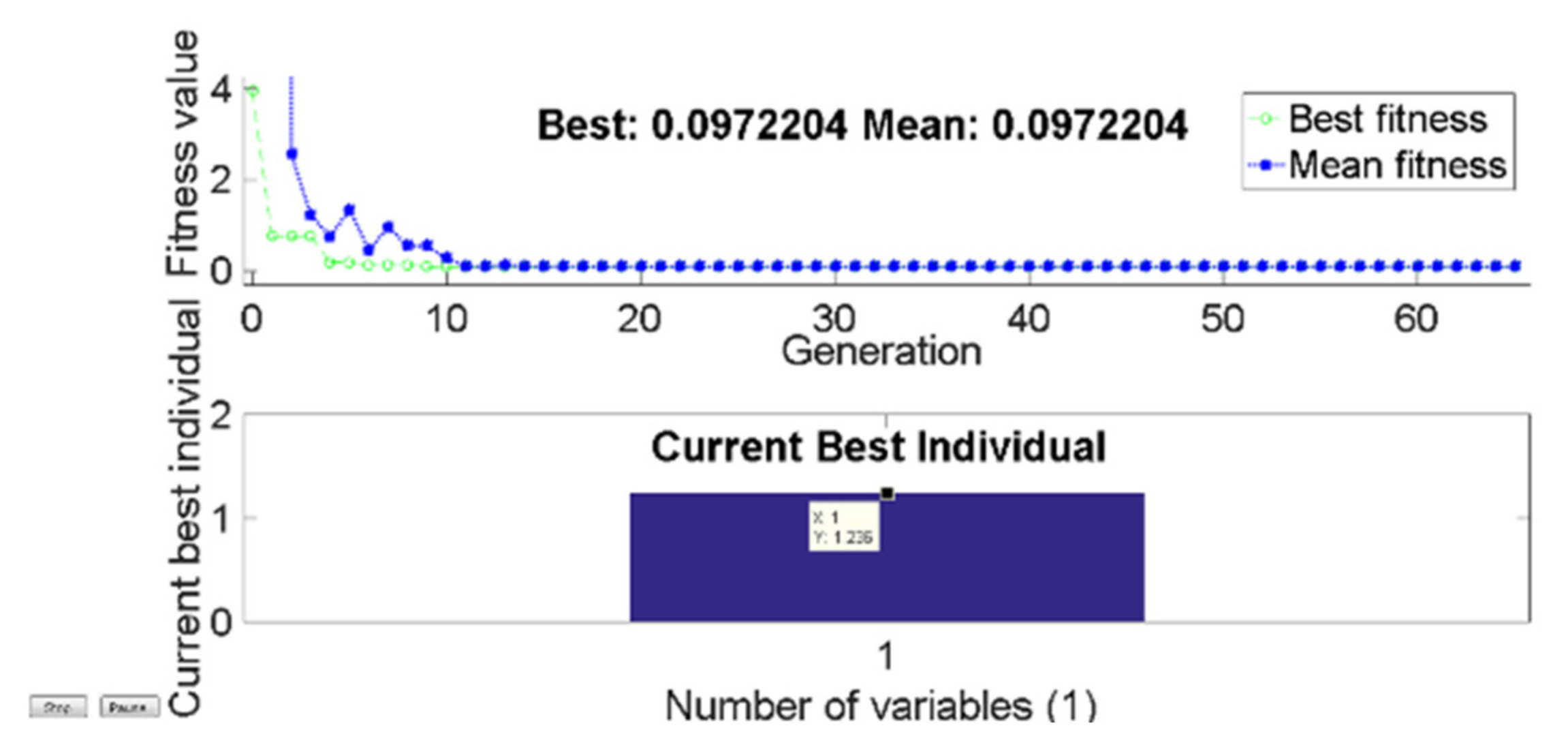

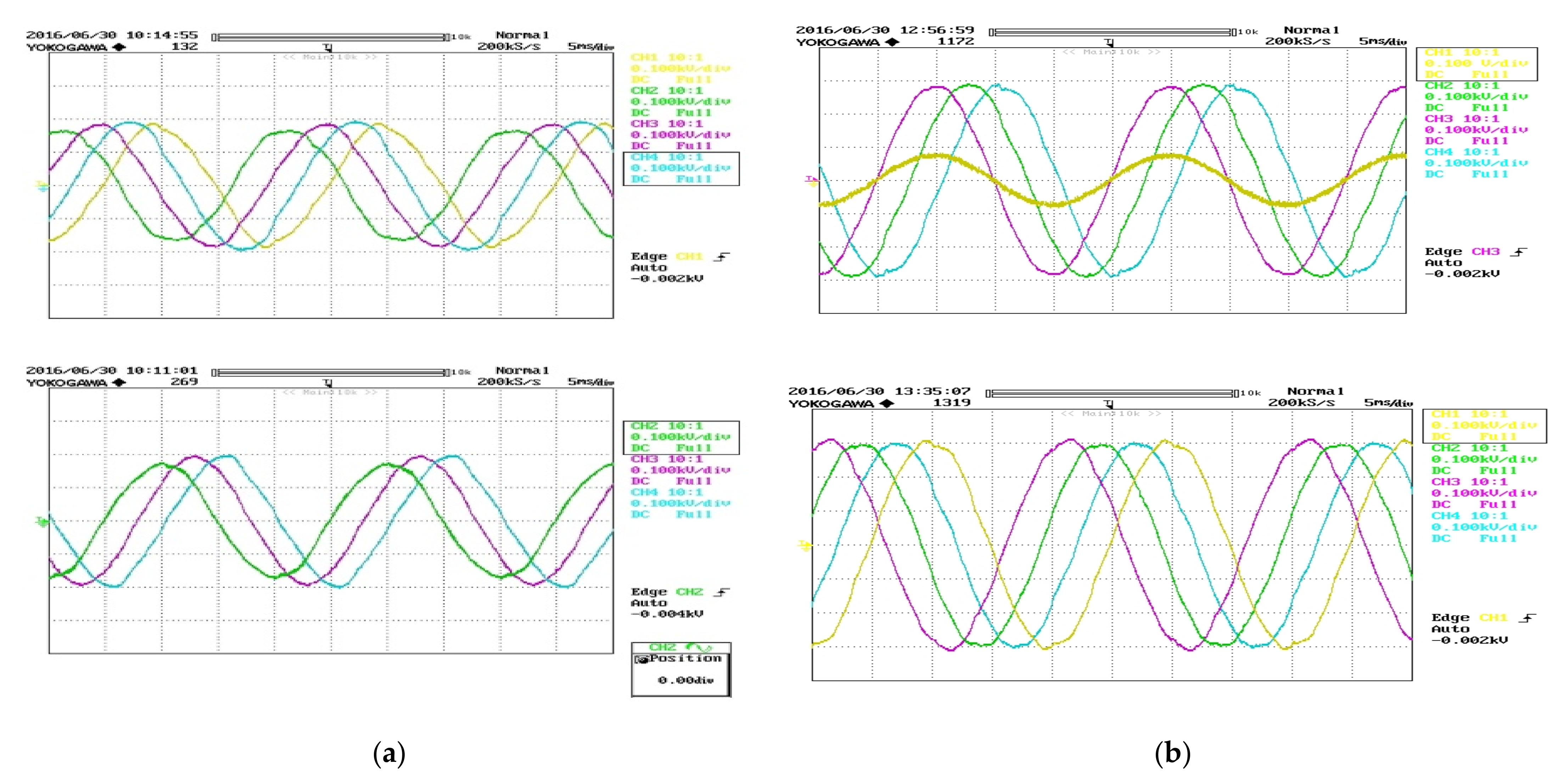
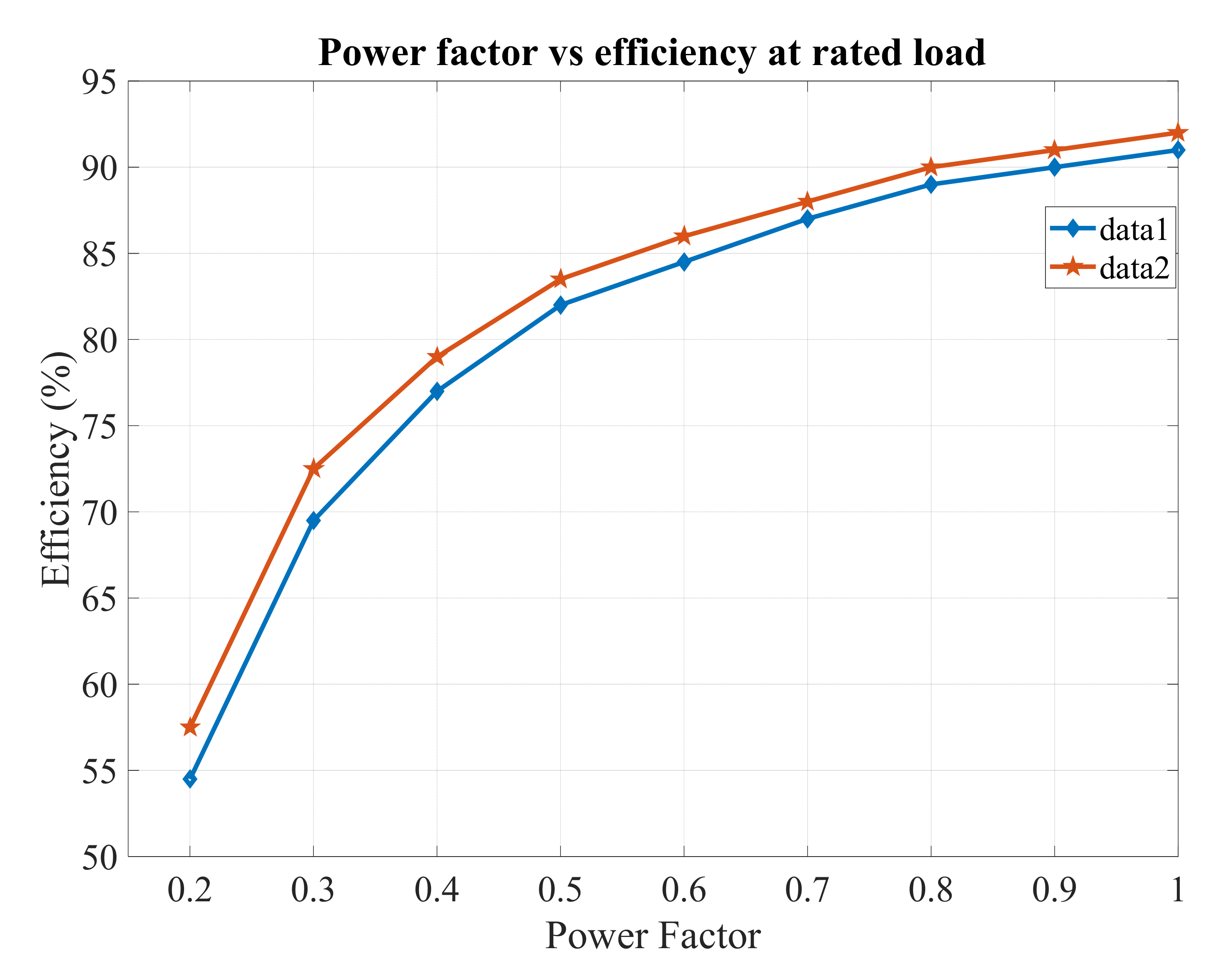
| Properties | Three-Phase Machine | Multi-phase Machines |
|---|---|---|
| Torque ripple frequency (f-fundamental frequency) | 6f | 2nf(>6f) |
| Ordre of the lowest spatial mmf harmonics | 5 and 7 | 2n + 1 |
| Power/Torque per-phase (P/Te) | P/3(Te/3) | P/n(Te/n) |
| Continues operation after an open-phase fault | Not possible without modification of the power converter topology | Continuous post-fault operation but at reduced capacity |
| Torque enhancement by stator current harmonic injection | Not possible | Yes (concentrated winding machines) |
| Transmission Line Towers | Higher Tower Heights, | Lower Tower Heights |
| Phase-to-Phase voltage at rated power | Higher | Lower |
| Magnetic Interference due to transmission lines and transposition requirements | Higher | Lower |
| Current/Conductor | P/3Vp (Vp is Phase Voltage) | P/nVp (reduced as n > 3) |
| Parameters | Configuration #1 | Configuration #2 | Configuration #3 |
|---|---|---|---|
| Total Primary Turns | 387 | 387 | 387 |
| Total Secondary Turns | 825 | 648 | 709 |
| Total Turns | 1212 | 1035 | 1096 |
| Primary Resistance (Ω) | 0.053 | 0.053 | 0.053 |
| Secondary Resistance (Ω) | 0.049 | 0.038 | 0.042 |
| Space required by primary (mm2) | 418 | 418 | 418 |
| Space required by secondary (mm2) | 1310 | 1030 | 1126 |
| Total space required (mm2) | 1728 | 1448 | 1544 |
| Winding | N2/N1 | Winding | N2/N1 | Winding | N2/N1 |
|---|---|---|---|---|---|
| a1a2 | 0.1721 | b1b2 | 0.7854 | c1c2 | 0.5010 |
| a3a4 | 1.000 | b3b4 | 0.5010 | c3c4 | 0.7854 |
| a5a6 | 0.1721 | b5b6 | 0.9028 | c5c6 | 0.3404 |
| a7a8 | 0.6505 | b7b8 | 0.3404 | c7c8 | 0.9028 |
| a9a10 | 0.6505 | - | - | - | - |
| α Axis | aα | β Axis | aβ |
|---|---|---|---|
| a1a2 | 1 | - | - |
| b1b2 | +0.6234 | b3b4 | +0.7818 |
| c1c2 | −0.2225 | c3c4 | +0.9749 |
| d1d2 | −0.9009 | d3d4 | +0.4338 |
| e1e2 | −0.9009 | e3e4 | −0.4338 |
| f1f2 | −0.2225 | f3f4 | −0.9749 |
| g1g2 | +0.6234 | g3g4 | −0.7818 |
| References | Configuration | Transformation Techniques | Primary Connection | Secondary Connection | Advantages | Disadvantages |
|---|---|---|---|---|---|---|
| [1,7,20] | m-Phase to n-Phase Transformation | -Two-Phase to n-Phase Transformation | -Scott | -Star or Delta alike | -Design is simple and straightforward. | -Unbalance in input as well as output side. |
| [21] | -Optimized Three-Phase to n-Phase transformation | -Star or Delta | -Star or Delta alike | -Winding materials used are minimized using optimization technique. | -Winding design is lengthy and cumbersome. | |
| [5,6] | -Phasor Algebra-based three-Phase to n-Phase Transformation | -Star | -Star or Delta alike | -No primary side unbalance. | -Winding design is complex. | |
| [22] | Three-Phase to Five-Phase Transformation | -Configuration 1 | -Star | -Star | -Simple configuration. | -Copper requirement is high. |
| [6,22] | -Configuration 2 | -Star | -Star | -Most economical design. | -Unbalance in input as well as output side. | |
| [7,22] | -Configuration 3 | -Star | -Star | -Copper requirement is high. | ||
| [5] | Three-Phase to Seven-Phase Transformation | -Configuration 1 | -Star | -Star | -No primary side unbalance. | -Winding design is difficult. |
| [20] | -Configuration 2 | -Scott | -Star | -Copper requirement is less. | -Unbalance in primary as well as secondary side. | |
| [21,25,26] | Other High Phase Order Systems | -Three-Phase to Eleven-Phase System | -Star | -Star | -Less number of windings required. | -Winding design is complicated as an optimization technique is used. |
| [28] | -Three-Phase to Thirteen-Phase Transformer | -Star | -star | -No primary side unbalance. | -Winding design is lengthy and cumbersome. |
| Three Phases | Seven Phases | ||
|---|---|---|---|
| Transformer Connection | Number of Pulses in a Cycle | Transformer Connection | Number of Pulses in a Cycle |
| Half wave (Star) | 3 | Half wave (Star) | 7 |
| Center tapper T/F | 6 | Center tapper T/F | 14 |
| Y–Y and Y–Δ | 12 | Star–star and star–heptane | 28 |
| --------- | 18 | --------- | 42 |
| --------- | 24 | --------- | 56 |
| --------- | 48 | --------- | 112 |
| Serial Number | Five-Phase System | Seven-Phase System |
|---|---|---|
| 1 | Positive Sequence | Adjacent Positive Sequence |
| 2 | Adjacent Negative Sequence | Adjacent Negative Sequence |
| 3 | Nonadjacent Positive Sequence | Nonadjacent1 Positive Sequence |
| 4 | Nonadjacent Negative Sequence | Nonadjacent1 Negative Sequence |
| 5 | Zero Sequence | Nonadjacent2 Positive Sequence |
| 6 | - | Nonadjacent2 Negative Sequence |
| 7 | - | Zero Sequence |
| Technique | Attained Optimum Value of k | Corresponding Value of Objective Function |
|---|---|---|
| GA | 1.2363 | 0.0972204 |
| PSO | 1.2364 | 0.0972200 |
| From Plot | 1.2360 | 0.0973 |
| Testing Methods | Applications |
|---|---|
| Thermal monitoring | Transformer condition monitoring and assessment |
| Partial discharge measurements | |
| dissolved gas analysis (DGA) | |
| Tan δ and capacitance | |
| Turns ratio, winding impedance and inductance measurement | |
| Magnetizing current measurements | |
| Thermal monitoring | |
| Reactance measurement method and low voltage impulse (LVI) | Winding deformations |
| Frequency Response Analysis (FRA) | Short circuits Loss of clamps Inter-disk fault Axial displacement Dielectric test of transformer bushings and associated faults |
Publisher’s Note: MDPI stays neutral with regard to jurisdictional claims in published maps and institutional affiliations. |
© 2021 by the authors. Licensee MDPI, Basel, Switzerland. This article is an open access article distributed under the terms and conditions of the Creative Commons Attribution (CC BY) license (https://creativecommons.org/licenses/by/4.0/).
Share and Cite
Tabrez, M.; Sadhu, P.K.; Hossain Lipu, M.S.; Iqbal, A.; Husain, M.A.; Ansari, S. Power Conversion Techniques Using Multi-Phase Transformer: Configurations, Applications, Issues and Recommendations. Machines 2022, 10, 13. https://doi.org/10.3390/machines10010013
Tabrez M, Sadhu PK, Hossain Lipu MS, Iqbal A, Husain MA, Ansari S. Power Conversion Techniques Using Multi-Phase Transformer: Configurations, Applications, Issues and Recommendations. Machines. 2022; 10(1):13. https://doi.org/10.3390/machines10010013
Chicago/Turabian StyleTabrez, Md, Pradip Kumar Sadhu, Molla Shahadat Hossain Lipu, Atif Iqbal, Mohammed Aslam Husain, and Shaheer Ansari. 2022. "Power Conversion Techniques Using Multi-Phase Transformer: Configurations, Applications, Issues and Recommendations" Machines 10, no. 1: 13. https://doi.org/10.3390/machines10010013







